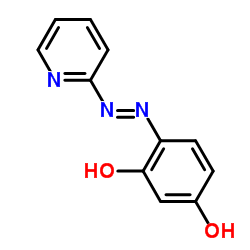4-(2-Pyridylazo)Resorcinol

4-(2-Pyridylazo)Resorcinol structure
|
Common Name | 4-(2-Pyridylazo)Resorcinol | ||
|---|---|---|---|---|
| CAS Number | 1141-59-9 | Molecular Weight | 215.208 | |
| Density | 1.3±0.1 g/cm3 | Boiling Point | 438.2±20.0 °C at 760 mmHg | |
| Molecular Formula | C11H9N3O2 | Melting Point | 192-202 °C(lit.) | |
| MSDS | Chinese USA | Flash Point | 218.8±21.8 °C | |
| Symbol |

GHS07 |
Signal Word | Warning | |
|
Selective Sensitization of Zinc Finger Protein Oxidation by Reactive Oxygen Species through Arsenic Binding.
J. Biol. Chem. 290 , 18361-9, (2015) Cysteine oxidation induced by reactive oxygen species (ROS) on redox-sensitive targets such as zinc finger proteins plays a critical role in redox signaling and subsequent biological outcomes. We found that arsenic exposure led to oxidation of certain zinc fi... |
|
|
Oxidation of Zn(Cys)4 zinc finger peptides by O2 and H2O2: products, mechanism and kinetics.
Chemistry 17(49) , 13762-72, (2011) The reactivity of a series of Zn(Cys)(4) zinc finger model peptides towards H(2)O(2) and O(2) has been investigated. The oxidation products were identified by HPLC and ESI-MS analysis. At pH<7.5, the zinc complexes and the free peptides are oxidised to bis-di... |
|
|
Unidirectional movement of cellulose synthase complexes in Arabidopsis seed coat epidermal cells deposit cellulose involved in mucilage extrusion, adherence, and ray formation.
Plant Physiol. 168 , 502-20, (2015) Cellulose synthase5 (CESA5) synthesizes cellulose necessary for seed mucilage adherence to seed coat epidermal cells of Arabidopsis (Arabidopsis thaliana). The involvement of additional CESA proteins in this process and details concerning the manner in which ... |
|
|
Removal of reactive red-120 and 4-(2-pyridylazo) resorcinol from aqueous samples by Fe3O4 magnetic nanoparticles using ionic liquid as modifier.
J. Hazard. Mater. 192(2) , 476-84, (2011) The nanoparticles of Fe(3)O(4) as well as the binary nanoparticles of ionic liquid and Fe(3)O(4) (IL-Fe(3)O(4)) were synthesized for removal of reactive red 120 (RR-120) and 4-(2-pyridylazo) resorcinol (PAR) as model azo dyes from aqueous solutions. The mean ... |
|
|
An inorganic-organic hybrid optical sensor for heavy metal ion detection based on immobilizing 4-(2-pyridylazo)-resorcinol on functionalized HMS.
J. Hazard. Mater. 201-202 , 155-61, (2012) A novel and low-cost optical sensor for heavy metal ion detection has been prepared by immobilizing 4-(2-pyridylazo)-resorcinol (PAR) on the functionalized hexagonal mesoporous silica (HMS) via N-trimethoxysilylpropyl-N,N,N-trimethylammonium chloride (TMAC). ... |
|
|
Development of an airborne lead analysis kit and its application.
Southeast Asian J. Trop. Med. Public Health 41(6) , 1500-11, (2010) We developed a method to analyze airborne lead concentrations in the field. It was a modification of the colorimetric method using the reaction between 4(2-pyridylazo)-resorcinol (PAR) and lead with cyanex302 in an acid medium to reduce interfering metals. Th... |
|
|
ESI-MS quantitation of iron as its 4-(2-pyridylazo)resorcinol (PAR) complex: application to pharmaceutical tablets containing iron oxide pigment.
J. Mass Spectrom. 46(5) , 508-16, (2011) Quantitation of iron oxide (Fe(2)O(3)) in pharmaceutical formulations using electrospray ionization mass spectrometry (ESI-MS) following iron complexation with 4-(2-pyridylazo)resorcinol (PAR) was evaluated. Complexation of Fe(III) with PAR was found to produ... |
|
|
A reactivity index study to monitor the role of solvation on the interaction of the chromophores with amino-functional silanol surface for colorimetric sensors.
J. Mol. Graph. Model. 25(2) , 208-18, (2006) Amino-functional silanol surface are mostly used for the immobilization of inorganic ions, molecules, organic or biochemical molecules onto the mesopore surface. In analytical chemistry, the metal ion uptake was visualized through colorimetric sensors using c... |
|
|
Preparation of a carbon ceramic electrode modified by 4-(2-pyridylazo)-resorcinol for determination of trace amounts of silver.
Talanta 80(5) , 1827-31, (2010) A 4-(2-pyridylazo)-resorcinol (PAR)-modified carbon ceramic electrode (CCE) prepared by the sol-gel technique has been reported for the first time in this paper. By immersing the CCE in aqueous solution of PAR (0.001molL(-1)), after a short period of time, a ... |
|
|
Investigation of para-sulfonatocalix[n]arenes [n = 6, 8] as potential chelates for (230)U.
Dalton Trans. 39(5) , 1366-74, (2010) Literature reports of the efficacy of para-sulfonatocalix[6]- and calix[8]-arenes as U(vi) complexants indicated that they might be useful for in vivo chelation of the novel therapeutic alpha-emitter (230)U. We have studied the complexation of U(vi) with para... |